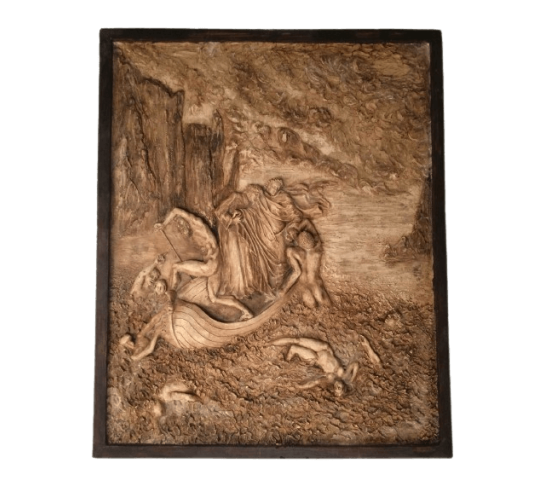- New
Low relief of Dante and Virgil crossing the Styx and repelling Philippo Argenti, The Divine Comedy after Gustave Doré
Features of our Low relief of Dante and Virgil crossing the Styx "The Divine Comedy":
Height: 130 cm.
Width: 79 cm.
Depth: 5 cm.
Weight: 33 kg.
Material: Resin.
Other possible materials: White plaster, reconstituted stone.
Available patinas: bronze, terracotta, marble, wood, polychrome, gilding, stone, or diorite. Contact us to inquire about the prices of our patinas (varying according to the desired color).
Handcrafted reproduction entirely made and patinated by hand.
In stock.
Delivery time: Approximately 1 to 3 weeks.
Dive into the depths of hell with this exquisite bas-relief, shedding light on the poignant confrontation between Dante, Virgil, and the condemned Philippo Argenti on the dark waters of the Styx, a piece of striking beauty.
Our low relief, inspired by Gustave Doré's famous engraving, offers a visually stunning representation of one of the most intense scenes in "The Divine Comedy." As Dante and Virgil navigate the sinister waters of the Styx, their boat is surrounded by tormented convicts, naked men and women plunged into an ocean of eternal suffering. Among them is Philippo Argenti, a figure laden with political and personal symbolism, representing the conflicts that marked Dante's life. His cry of despair and anger when he recognizes Dante, his longtime enemy, is poignant. His plea for help, even in his torment, raises questions about the nature of repentance and redemption.
Virgil's reaction, marked by moral firmness and disgust, highlights the rigor of divine judgment against those who have succumbed to injustice and hatred. His gesture of pushing back Philippo Argenti, merciless yet dignified, is emblematic of the relentless justice of the afterlife. Despite the desperate pleas and cries of anger from the damned, the boat inexorably advances, guided by Phlegyas, symbolizing the inevitable course of destiny and the divine justice that governs Dante's universe. This captivating scene reflects not only the torments of hell but also the inner struggles and moral choices that everyone faces in their quest for redemption and salvation.
An artistic testimony of the human condition: Bas-relief inspired by Dante's epic, a masterpiece for literature and art enthusiasts!
The figure of Philippe Argenti in "The Divine Comedy" embodies political betrayal and greed, serious sins in Dante's moral vision. His appearance in the circle of the wrathful reflects the gravity of the sin of betrayal and the disastrous consequences that ensue in the afterlife. Dante uses this encounter to highlight the consequences of human actions and the divine justice that prevails even after death, inviting the reader to reflect on their own choices and the path to spiritual reconciliation.
The captivating scene of the bas-relief Dante and Virgil crossing the Styx and repelling Philippo Argenti offers a profound meditation on the human condition, the nature of guilt, and the power of redemption. This work invites literature enthusiasts to delve into the depths of the human soul and explore the complex and universal themes addressed by Dante Alighieri. With its rich symbols and moving representation, this bas-relief is an impressive addition to any art collection and offers a unique opportunity to meditate on the ethical and spiritual questions raised by Dante's timeless work.
Explore the intricacies of the human soul: Bas-relief of Dante and Virgil crossing the Styx and repelling Philippo Argenti, a masterpiece of depth and reflection, an invitation to contemplate humanity.
In this striking scene from "The Divine Comedy," Dante Alighieri skillfully uses a range of symbols to explore complex and universal themes. The sinister waters of the Styx are not just a backdrop, but a mirror of the inner torments and hidden sins of the damned souls. The condemned, trapped in this ocean of eternal suffering, symbolize the ultimate consequence of human choices and the need to face the consequences of one's actions. The presence of Philippo Argenti, with his desperate cry and burning anger, can also be interpreted as a representation of man's internal struggle between redemption and damnation, between the will to change and resistance to change. Virgil's reaction, pushing back Philippo Argenti firmly but without cruelty, may reveal humanity's compassion and understanding in the face of suffering, even for those who have succumbed to evil. Phlegethon, as the boatman, embodies the relentless fate and divine justice that guides souls through the twists and turns of hell, emphasizing the importance of accepting personal responsibility and the consequences of one's own actions. Overall, this complex scene offers a profound meditation on the human condition, the nature of guilt, and the power of redemption, inviting the reader to reflect on their own choices and the path to spiritual reconciliation.
Elevate your Art Collection with this Captivating Low Relief: The Divine Comedy, an Allegory of Nature and the Human Soul!
Explore the unfathomable depths of the human soul through this fascinating bas-relief "Dante and Virgil crossing the Styx," inspired by Dante Alighieri's "The Divine Comedy" and beautifully inspired by Gustave Doré. Immerse yourself in a universe where symbols and metaphors intertwine to offer a striking reflection on the choices and consequences that shape our destiny. Discover a work of unparalleled narrative and artistic richness, where every meticulous detail tells a deep and timeless story about the nature of humanity. Let yourself be transported on a journey through the twists and turns of hell, where the torments of lost souls resonate with unforgettable emotional power. With this bas-relief, you bring home a work that goes far beyond aesthetics to become a source of daily inspiration and reflection. It is an acquisition that will enrich your living space while nurturing your spirit, offering you a unique opportunity to delve into one of the most iconic works of world literature. Don't miss this opportunity to own a piece that embodies the quintessence of art and philosophy, and that will continue to evoke admiration and contemplation for years to come.

















